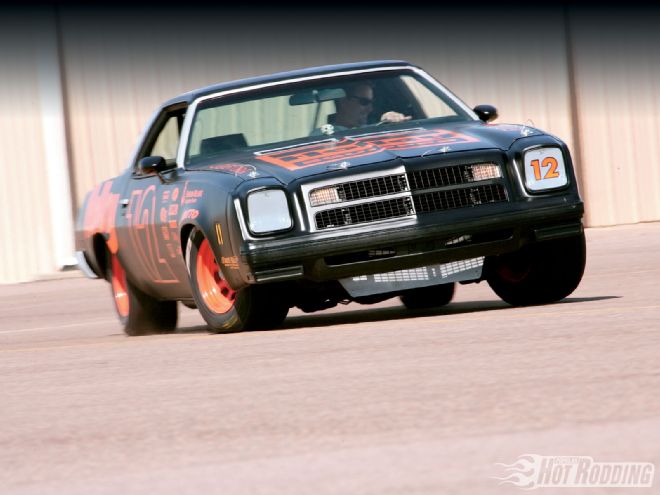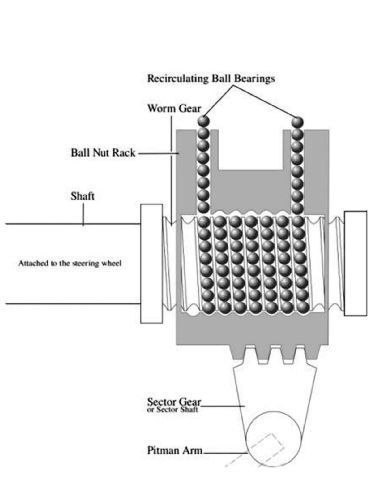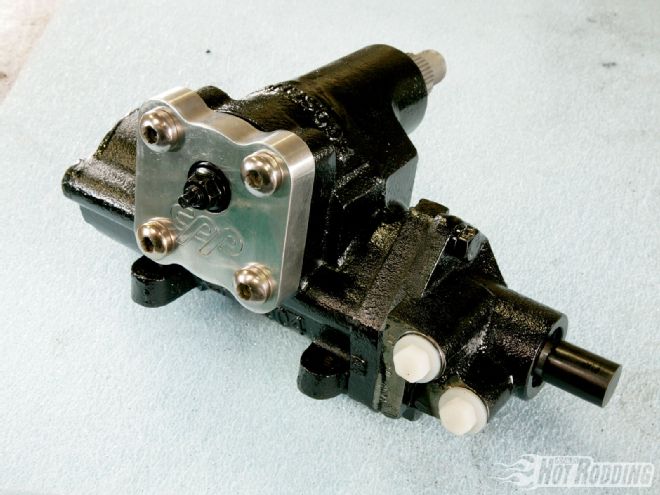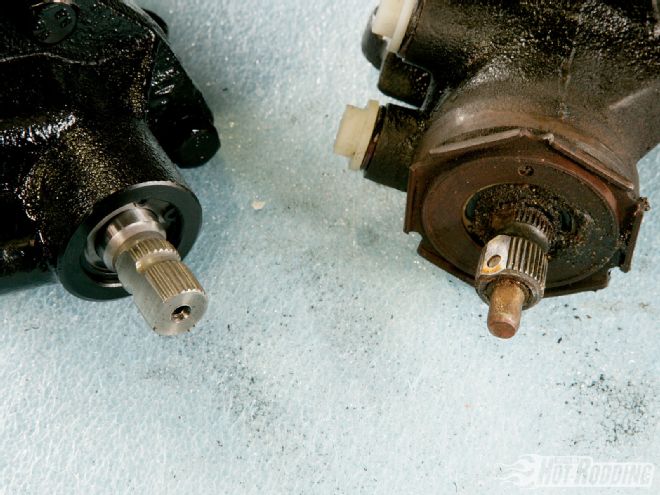
Whether you dig the Pro-Touring movement, and its attendant propensity for big g-force turns or not, you will at some point need to turn the corner. Even drag racers need to turn, and if your tires don't mimic the directional input of the steering wheel, you, my friend, are in serious trouble. Virtually all muscle cars were equipped with recirculating ball and nut steering (sometimes called worm and sector). This type of steering box was almost universal in domestic cars through the 1980s; they're simple, they work, and their universal nature means they're compatible in cars of widely varying vintage (read: easy bolt-on).
The original steering box in our '75 Laguna project car is a recirculating ball-type box-no surprise there. It's also no surprise that after 34 years, it's a bit tired. A worn steering box can be dangerous-even fatal-if not rebuilt or replaced. Fortunately, worn steering boxes of this design have some pretty specific symptoms that you can be on the lookout for. Let's take a peek at how the recirculating ball steering mechanism works, and see where problems can arise.
The box's input shaft is mechanically linked to a worm gear inside a block. The block and the gear both have a spiral, cylindrical channel milled in their mating surfaces that ball bearings ride in. When the worm gear is turned by the steering wheel, the block moves in relation to the rest of the chassis; a sector gear on its side acts on the gear teeth of a shaft that splines to the pitman arm. In a traditional worm gear, the mating faces between the worm gear and the nut (i.e. block) are in direct contact, but in a recirculating ball worm gear, the ball bearings take the brunt of the contact force in order to reduce friction, and to reduce slop in the gear assembly. This is a very tight tolerance setup, but over time, the channel and the ball bearings themselves, become worn. As the balls make contact, they ride up on each other, accelerating the wear on the balls and their worm channel. This can be felt in the steering wheel as a brief resistance to being turned, sometimes when you need it most. The resistance stutters on and off as you turn, and becomes worse with increased input effort. Another negative effect of ball and channel wear is that the slop increases as the clearance loosens up. At best, it causes a numb on-center feel with a continual need for correction to drive straight, and at worst, it can cause a loss of control.
 Unless you've had a recirculating ball-type steering box apart, it might be kind of hard to visualize what's going on inside. In this diagram, you can see how the worm gear works on the block (called the ball nut rack here) through the ball bearings. The block then acts on a sector gear attached to the pitman arm. Trouble arises when the ball bearings and the spiral channel wear out, creating excessive clearance.
Unless you've had a recirculating ball-type steering box apart, it might be kind of hard to visualize what's going on inside. In this diagram, you can see how the worm gear works on the block (called the ball nut rack here) through the ball bearings. The block then acts on a sector gear attached to the pitman arm. Trouble arises when the ball bearings and the spiral channel wear out, creating excessive clearance.
So here we were with a 34-year-old gearbox sporting a bad attitude. It bore all the symptoms of a dying box: a jerky resistance to being turned, lots of on-center slop, and the occasional loss of hydraulic boost when turned in one direction. This last trait was symptomatic of a worn-out rotary valve, which is responsible for directing hydraulic pressure to either side of the worm block. Simultaneous to this, we received news that Classic Performance Products (CPP) had just released a new 500 Series gearbox. The timing seemed too perfect to be a coincidence.
CPP's Series 500 steering box is an all-new (not remanufactured) unit that is a direct bolt-in for most Chevrolets. Currently, CPP has Series 500 gearboxes to fit '55-57 Chevy, '58-64 Chevy, Nova, Camaro, Chevelle, and full-size Chevy through 1970. They also have one to fit our '75 Chevy Laguna, which fits all '73-77 GM A-bodies. CPP's Series 500 box has an updated spool valve, which endows the box with a sharper, more rack-and-pinion-type feel. While the folks at CPP could've chosen to produce their Series 500 box with a more aggressive 12:1 ratio or a stock 18:1 ratio, they wisely gave it a 14:1 ratio, which is a great compromise between laid-back cruising, and hard-core autocrossing. The 14:1 steering ratio of the Series 500 keeps it comfortable to drive, while providing much better steering feel and road feedback than stock.
 With a steering ratio of 14:1, the Classic Performance Products' Series 500 steering box offers the perfect compromise between all-out corner carving and comfy highway cruising. Since we plan on doing both with the Laguna, and we didn't want to go overboard with a very un-NASCAR rack-and-pinion setup, the Series 500 got the nod. The $379 price tag and true bolt-in status sweetened the deal.
With a steering ratio of 14:1, the Classic Performance Products' Series 500 steering box offers the perfect compromise between all-out corner carving and comfy highway cruising. Since we plan on doing both with the Laguna, and we didn't want to go overboard with a very un-NASCAR rack-and-pinion setup, the Series 500 got the nod. The $379 price tag and true bolt-in status sweetened the deal.
Those of you who have been around the block with steering box replacements before will be pleased to know that the Series 500 is a true bolt-on-and we mean that in the sense that you won't need to chase special hardware, fittings, or couplings. The Series 500 is a three-bolt box that attaches in the stock location with the stock fasteners. No biggie there, as most aftermarket boxes claim that as well. The box employs a 3/4-inch, 30-spline input shaft, which is the most common. CPP offers the proper rag joint (PN RJC-730R) for $49 extra, which is highly recommended. Put one more check in the column for CPP. Best of all, Series 500 boxes come with the appropriate adapters to work with your existing hydraulic feed and return lines. This means older compression-style, flared-end fluid lines can easily mate to the late-model O-ring-type ports in the Series 500 box. No need to build or buy new hoses or track down adapters of dubious quality. Awesome!
CPP's Series 500 steering box costs $379, which includes the adapter fittings and an attractive (and protective) aluminum sector gear cover. With those features at that price, we knew the Series 500 was the right choice for our aging Laguna. We needed a box that would thrive on the highway, not needing excessive directional correction to stay on course. We also wanted something a bit more aggressive than stock, so we could hit the road course or autocross without too much sawing at the wheel. The Series 500 sounded perfect, and fit the bill for an easy installation too. Having used CPP products in the past with our Street Sweeper '68 Chevelle, we knew the quality would be outstanding, and we wouldn't be disappointed this time either.
 The Series 500 box (left) has a 3/4-inch, 30-spline input shaft, while our Laguna's original box had a 13/16-inch, 36-spline input shaft. Since you will undoubtedly want to replace the rag joint on the steering box side, the difference doesn't matter-just order the correct rag joint for the new box.
The Series 500 box (left) has a 3/4-inch, 30-spline input shaft, while our Laguna's original box had a 13/16-inch, 36-spline input shaft. Since you will undoubtedly want to replace the rag joint on the steering box side, the difference doesn't matter-just order the correct rag joint for the new box.
We set up an appointment with CPP, and brought our Laguna to their facility for a quick morning installation. It took about two hours for CPP technician Craig Chaffers to make the swap, and there were zero surprises. Back on the road in time for lunch, the Laguna was the poster boy for directional control, as the Series 500 box worked in perfect concert with the new Global West suspension. Gone was the slop of our original "widow maker" box, and in its place was a razor-sharp feel with confidence-inspiring cornering. As with the Global West suspension, the Series 500 box had the effect of making the car feel lighter and more "tossable," which was an unexpected surprise. Before hitting the highway, we were concerned that such a sharp-feeling box might dart around too much at high speed. Once we hit the freeway, we discovered that the Series 500 aimed straight as an arrow, needing little to no correction to stay on track.
If you are contemplating a steering upgrade for your aging stock steering box, and you don't want to pay a lot of money for a rack-and-pinion conversion (or you don't need anything that hard core), the CPP Series 500 should be perfect for you. It's got a tight, sporting feel without the "dartiness" of some fast-ratio boxes. It's simple and easy to install, and it won't break your bank. Plus, the all-new construction and high quality will keep it rolling down the road for decades to come.
PROJECT TALLADEGA
THE COST SO FAR
Description:
PHR Issue:
Cost:
'75 Chevy Laguna
Oct. 2008
$5,000
Phoenix 700R4 trans, flexplate and converter
Feb. 2009
$2,800
Sherwin Williams paint, materials, and labor
March 2009
$3,979.73
Makeover (tires, wheels, graphics, seats, etc.)
April 2009
$2,989.95
408ci solid-roller small-block
May 2009
$7,685
Global West rear suspension
June 2009
$1,699.36
Global West front suspension
July 2009
$2,569.83
Global West front brake upgrade
Sept. 2009
$1,118.45
Engine and trans installation
Oct. 2009
$3,430.36
Dr. Gas side-exit NASCAR exhaust
Nov. 2009
$981.46
CPP 500 Series steering box
Dec. 2009
$428
Total:
$32,682.14
WHERE THE MONEY WENT DESCRIPTION: SOURCE: PART NO.: COST: 500 Series steering box CPP CP50004 $379 ¾-inch 30-spline rag joint CPP RJC-730R $49 O-ring/flared adapters CPP NA included with box Total: $428